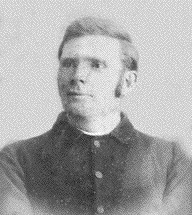
Rev. Hugh Walker Taylor, 1881-1891 (to 1896 in Bulli)
The Anglican Parish of Helensburgh with Stanwell Park began its life as part of the Parish of Bulli. The South Coast, between Sydney and Wollongong, was renowned for violence and drunkenness. it was to the boom towns along the Illawarra line that the Church of England minister of Bulli had pastoral oversight. The church district had been constituted in 1881 with the first minister, Rev. Hugh Walker Taylor, B.A. He served for 14 years. The district ran from Sutherland to Bulli. So it was that
Lay catechists visited the growing towns along the line, holding services wherever possible. Other ministers visited the areas, especially a number of Methodist evangelists, although it wasn’t until 1903 that the Helensburgh Methodist circuit was formed.
Their presence in Otford was observed with favour by some onlookers. “The gentlemen who have been lately holding religious service, will, it is thought, soon reduce things into some order amongst us.” They obviously had some impact for by 1887 the locals had built a new “English” church at Otford. It was called St. Hallows, was built of brick with a seating capacity of 200. The church was to disappear without a mark, and even today no one can explain why. Mrs. Vardy (nee Lucas), once a longtime resident of Otford, can remember her family home a few doors down from the school. It had one brick wall with windows in the shape of a church window. Her father told her it was the remains of the old church. The wall was always damp and so it was demolished when she was a young girl. The church was probably constructed by the railway tunnel bricklayers who left the district in 1889. There is no recorded use of the building by Anglican clergy appointed to Helensburgh. The assumption is it was destroyed at some time prior to 1891.
Rev. H. Walker Taylor ministered to an area South of Bulli and North to Sutherland. Sylvania was visited by the Rector of St. Paul’s Kogarah, the Rev. W.K. Bowers. At Helensburgh, Rev. Taylor conducted the first church service under a gum tree on a clear moonlight night. It was held in the Colliery Paddock, opposite the present Catholic School. Later, as railway ganger camps became more established, services were conducted in a rough demountable building called St. Anne’s. Such buildings were moved from camp to camp. By 1887 records show that serious discussion was underway for the establishment of a permanent home for the Anglican community in Helensburgh.
By 1890 the railway camps had moved on and services were being held in the new School of Arts hall (later to become the RSL hall – the Community Centre is now on this site). Private homes were also used, namely Mr. & Mrs. Miller’s home. Oral tradition has it that a more permanent home for the Anglican congregation was arranged with the transporting of a disused hall from Otford to the existing Anglican church site. This building was used for services and later became the “School Hall” (the present church hall) minus the present stage and kitchen.
Rev. Taylor was 25 years old when he began his ministry in the Bulli Parish. His first purchase on leaving the ship at Port Wollongong, was a horse for his visits up and down the coast. Miss Annie Turnbull, the young daughter of the Bulli postmaster at the time, once recalled a day spent with the vicar when he visited various homes in his horse and sulky. She remembered seeing Lawrence Hargrave, covered with bandages from head to foot. “What have you been doing?” the vicar asked him with a smile on his face. (“He knew”, she said). Annie looked with pity at the foolish man who really thought it was possible to fly. That night, when she arrived home, her mother questioned her about the day. She was excited about her adventures and volunteered the information that the vicar drank 29 cups of tea. About fifty years later, when she visited him in hospital in Sydney shortly before he died, they both laughed together as he said, “I’ve never quite forgiven you for telling your mother about those 29 cups of tea.”
Life was hard and industrial troubles rife throughout the Parish. Rev. Taylor played a decisive role as a mediator between the workers and management, especially during “the great strike”. When the strike ended he took a year’s leave of absence in order to further his studies in Europe. He was just embarking when news reached him of an enormous Bulli mine disaster. Cancelling his immediate plans, he returned to his parish to officiate at the funerals and comfort the bereaved. Eventually he did set sail for England, but returned to continue his eventful 15 year incumbency. Until he finished his work in the Illawarra, he put marriage out of his mind. At his funeral service many years later, an old Welsh miner who remembered him from the early day, jumped to the side of the grave and gave and impromptu oration for “God’s man in the Illawarra.”

Rev. Joseph Bosworth, 1891-1896
The original Rectory to the right of the church –
Rev. Taylor had broken the ground during turbulent and exciting years, but now the new Archbishop, Saumarez Smith, moved to create the Mission district of Helensburgh. To the task he appointed Rev. Joseph Bosworth in 1891 to the Provisional District of Helensburgh. The financial support for this ministry came from the Church Society (the forerunner of the Home Mission Society). His area of oversight was Sutherland, South to Stanwell Park.
As well as all his duties he had to set about building suitable places of worship. We usually shudder at the thought of supervising one project, but he had a vast area that would need many church buildings. So they were built – 1892 the Church of the Holy Redeemer Helensburgh, still the only church in the Sydney diocese with this name. It simply means “the Church of Jesus our Saviour.” Next came Christ Church Heathcote, 1893. The building was situated on the Old Illawarra Rd. (Princes Highway) close to the existing Heathcote hotel. It was later moved to its present site and extended when the highway was widened. Next came St. John the Baptist Sutherland, dedicated on 4th March 1894.
The Helensburgh church was built by George Rickett, a local builder. It was the normal construction of the day, weatherboards, stud framing on wooden piers with an iron roof. He was later to add the stage and kitchen to the “School Hall” in 1928/9. In later years George moved from Helensburgh to Stanwell Park where he built a two story home for himself three blocks down from St. George’s Church of England. He also built St. George’s in 1914, specially braced with wings to withstand the Southerly busters.
The original Helensburgh church went through a number of changes during its lifetime. The porch and vestry were the earliest additions. In 1925 electric light was installed and in 1927 the acetylene lamps, now made redundant, were removed. In 1931 the belfry started to disintegrate and so it was dismantled and a timber framed bell tower erected behind the vestry. The coloured pink, green and white glass lead light were installed in 1932. A door was added to the porch in 1935 after some of the local lads attempted to light a fire in the porch one evening. The memorial stained glass windows were added in 1949. They were memorials to Mr. Pell and Mr. Dorey. Mr. Pell’s window was paid for by the congregation in appreciation of his service to the church, while Mr. Dorey’s window was donated by his wife. In 1954 a new vestry was added at the rear of the church and the old vestry turned into a Baptistry. The final alteration was the addition of double doors to the front of the porch.
The opening service at the Church of the Holy Redeemer was taken by the Archbishop on 29th May 1892. There were two services, both full houses. The Helensburgh Anglican community now had a permanent home.
Bosworth established three geographical centres of worship with Helensburgh as his home base. At Helensburgh services were held weekly, while Heathcote and Sutherland had two services a month. The arrival of a minister and now new church buildings, was a great boon to prospective marriages. Up till 1892 the Paragon hotel (built 1889) or private homes, were the main venues for marriages, but now the church buildings became the popular venues for weddings.
Rev. Bosworth’s Sunday duties were mainly taken up by travelling. The horse and sulky was the main means of transport for the local ministers until the arrival of Rev. Creighton and his motor car in 1924. Of course, the horse may not have been as fast as a car, but it was more reliable. Rev. Smee probably would not have agreed entirely with this view when on April 3rd, 1921, his horse bolted from the church yard and he had to cancel the service up north.
Two external factors from the earliest times affected the congregation. First, there was the weather. A year would not go by without a service being cancelled due to a fierce storm. Second, there were the mine dispute and strikes. As early as 1894 strikes by the mine workers affected the offertories. The mine slow down from 1929 through to the end of the Great Depression also had a marked effect upon finances. Helensburgh was a mining town and all suffered together when the mine was not working at full capacity.
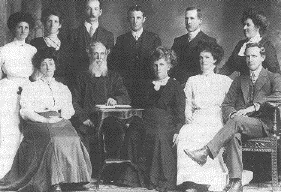
Rev. John Wilson, 1896-1906
Rev. Bosworth left the Parish in 1896, and for six months services were taken by Rev Joseph Cook and Rev. J. Ollis. Toward the end of the year the Archbishop appointed the then curate of St. Stephen’s Newtown, Rev. John Wilson, as mission curate to the Provisional District of Helensburgh. Rev. Wilson arrived with his large family and soon settled in to the district. His boys were particularly good at sport and joined the Illawarra Australian Football Club. The club were the premiers in 1906. John had gained his MA in Belfast and on coming to Australia was ordained in 1889 in Bathurst. His stipend was 175 pounds p.a.
From the centres now established by Rev. Bosworth, Rev. Wilson moved to set up outlying mission churches at Waterfall, Otford, Lilyvale, Cawley and Darkes Forest to the south, and Miranda, Cronulla and Audley to the north. These meetings were usually held in private homes. For example, Miranda Anglicans met in a home on the cnr. Wandella Rd and The Kingsway.
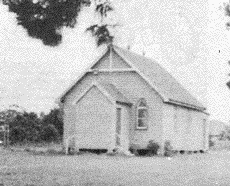
The original St. Luke’s Anglican Church, Miranda
Development work continued. Under Rev. Wilson, the Miranda Anglicans began a building fund in 1889 with a social. The present site for St. Lukes was obtained on lease from the Holt-Sutherland Land Co. at 1 pound per annum. On 3rd April, 1899 a foundation stone was laid by the Archbishop Saumerez Smith with Rev. Wilson leading the service. A loan of 60 pounds was gained from the Church Loan Building Society for the construction of the new Mission Hall by Mr. J. Paton, cost 92 pounds. The Archbishop again visited for the service of dedication, 4th November, 1899. The offertory was 2 pounds 1/6.
It was obvious that the mission area was oversized and so the Sutherland Provisional District was formed in 1901 with Rev. Bowers as the Missionary Curate. Sutherland was to became a parish in 1920. Heathcote remained linked with Helensburgh.
Rev. Wilson used Lay Readers from Sydney to lead the many Sunday services now running regularly in the Parish. They travelled by train and were able to deduct their travelling expenses from the collection (if it was large enough). The total collection in the Parish during this period amounted to around one pound per week. In 1899 the first Confirmation service was held in the district at the Church of the Holy Redeemer. There were 40 communicants present and Archbishop Saumaraz confirmed 6 males and 13 females.
Rev. Wilson retired to his home at Hurstville, but spent weekends at his holiday cottage, Flavian Court, at Heathcote. He was to die at Flavian Court. It was a beautiful local home, but was destroyed in the Black Friday bushfire of 1939.
Rev. Harry Gowing, 1907-1909
The third minister appointed to the district was Rev. Harry Gowing. He was married and it seems that during his stay the Sunday School was commenced. It was held every Sunday afternoon at 3pm. Special children’s services were held once a month. It was not until the 30s that the Sunday School was held in the mornings. Services continued at Otford in private homes and at outlying centres. With the construction of the Tuberculosis sanitarium at Waterfall (Garrawarra) in 1911, the Anglican minister of Helensburgh served as one of the chaplains. This involved taking Sunday services and numerous funerals.
When work began on the deviation in Otford, around 1914, Mr. James’ shop lay in the way of the new line. A new shop and residence was constructed for Mr. James by the railways and the old shop was moved and used as a site office. At the completion of the deviation the building and land was handed back to the community as a local hall. It became the centre for Sunday church services until it burnt down some 50 years later. It was used by the Progress Association who constructed a tennis court in front of the hall. It had the name Mr. James’ hall.
In 1909 an Anglican church was constructed in Waterfall and given the name St. Paul’s. It was a small weatherboard building situated in McKell Ave. up from the school. It contained hand hewn furniture and was lit by kerosene lamps. Because the village of Waterfall never had a large population, the church struggled to survive. The electric light was installed in 1948.
Rev. Thomas Cato, 1909-1911
The fourth minister appointed to the mission district of Helensburgh was Rev. Thomas Cato. He was followed by Rev. William Knox who served as locum tenens until the arrival of the fifth minister, Rev. William Price.
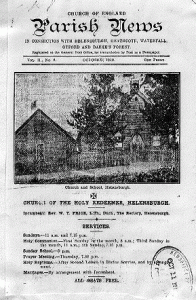
Rev. William Price, 1911-1914
Rev. & Mrs. Price made quite an impact on the Parish during their short stay. Since Rev. Wilson’s missionary period, there had been a decline in numbers and the buildings were falling into disrepair. Mrs. Price set about mobilising the ladies of the parish for a Bazaar (or “sale of work”) to raise funds. The tradition established in her day has continued till today, although not on the same lavish scale. In later years the Helensburgh brass band would play at the yearly Bazaar. She organised a boys’ choir and a full sung service was performed at 11am and 7pm. Harvest festivals boomed during this period and continued up to the 50s. Produce was collected by a horse dray from local farms and backyard gardens. This produce was loaded into the church until it was literally overflowing. Sheaves of corn decorated every pew. During the following week the foodstuffs were auctioned off. Rev. Price set about on a systematic visitation of the town, he organised a Bible Study, a youth group, and men’s meetings. To fix up the buildings he would invite miners on the way home from work to give him a hand. The men of the town thought a lot of the vicar who could roll up his sleeves.
One of the major events of the time was a Parish Mission held in November 1913 by Everard Digges la Touche. It was timed to coincide with the arrival of railway gangers at Bakers Camp which was close to where the Helensburgh tip is today. The meetings were held over the whole week with the final service on Sunday attended by 130 people. Digges la Touche was a powerful speaker and left quite an impression upon the congregation. He was soon to give his life for his country at Gallipoli.
Another outreach by the Helensburgh church was the building of the Stanwell Park Mission Church. The Stanwell Park community was now a thriving village, mainly catering for holiday makers and retired people who had bought up land in the 1908 Stanwell Estate Subdivision auction. An allotment was obtained in 1913 next to the school site and close to the shopping centre, and was fully paid off in 1915. The foundation stone was laid by Rev. New Newmarch, 20th December 1913 and the building work completed in 1914 with the first service held on Sunday February 14. The first sermon was preached by Rev. Begbie, rector of All Souls Leighardt who was a well known local resident during his annual holidays. His text for the day was “Till He Come.” The youth of All Souls Leichhardt later cut out the text of the sermon in plywood and attached it to a board which still hangs in the new chapel. The building itself remains much the same as it was in 1914, except that the internal dividing wall was moved into the church proper to widen the hall during the war years. The inside of the church was also lined some years after construction, and in 1934 Mrs. Surtees paid to have the electric light connected in memory of her late husband. The building later became the church hall with the construction of a new chapel at the rear of the block in the mid 1980s. Strangely, it was not till some years later that the Stanwell Park Mission Church was given the name St. George’s. From 1914 a Sunday School was held in the church, the first teachers being Mrs. Anger and Mrs. Alice Morrison.
Prior to the building of the church in 1914, services were held in private homes. Many such services were held on the front verandah of Rev. and Mrs. Begbie’s home “Mahanaim” (God’s second resting place). The home was later partly destroyed by fire.
In the early years of Stanwell Park, a number of clergy built holiday retreats. Along with Rev. Begbie there were Canon and Mrs. Arrowsmith, Rev and Mrs. Crawford, Rev. and Mrs. Connoly, Rev. and Mrs. Short, Rev. and Mrs. Theo Hayman and Rev. and Mrs. Oliver. The Olivers had purchased a beautiful home from the Gartrell White family.
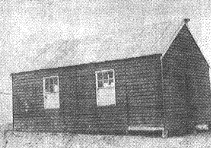
Rev. Reginald Smee, 1914-1921
Rev. Price was succeeded in 1914 by Rev. Harris Walker who served till the sixth minister Rev. Reginald Smee. Rev. and Mrs. Smee and family worked to build up the congregation, spiritually and materially. Mrs. Smee’s bible class could be remembered years later, even chapters from the Bible were committed to memory. One such chapter being John 14. The Bazaar and socials continued as before, to help raise finances. Rev. Smee founded the Helensburgh Scout Troop which met in the church hall through till 1938. The ministers that followed Rev. Smee, namely, Peat, Creighton, Gee and Kennedy were all active Scout masters, and consolidated the Rev. Smee’s initial efforts. From this time on there were quite a few glass bills for the hall. As with the other ministers, he taught scripture in the Public School and continued the practice of taking his classes to a special Ash Wednesday Service in the church.
Services at Helensburgh were now 8am, 11am and 7.15pm, with a mid-week service. The total congregation on Sundays averaged around 130. The Mission centres continued as before with some services held in the demountable church at Bakers Camp.
The war years were difficult ones for Rev. Smee and the congregation. The loss of life, industrial disputes and then later the influenza epidemic, made them difficult times. Smee himself was hospitalised in July 1919 with the flu.
As life returned to normal the congregation started to concern itself with the wider mission of the church. The Church Missionary Society and the British and Foreign Bible Society were faithfully supported from this time on. The congregation was still not self supporting. The Church Society (later known as The Home Missionary Society) supported the annual stipend of 200 pounds to the tune of 150 pounds. Helensburgh was a poor community. None-the-less the congregation worked to stand by itself. The core group was now strong enough to form a Parish Council. The church was no longer just one man. Between 1914 and 1923 some of the Wardens were as follows: Dr. Cox, Mr. Wheeler, Mr. Knight, Mr. Denning, Mr. Edmondson, Mr Bert Smith, Mr. Ivor Morgan, Mr. Doyle, Mr. Sutton and Mr. Stevenson. Some of the Committee members were: Mrs. Lomkins, Mrs. Cox, Mrs, Wheeler, Mrs. Smith, Mrs. Pell, Miss Kelly, Mr. Knight, Mr. Wheeter, Mr. Reins, Mr. Stanley and Mr. Cambridge.
Rev. Reginald Peatt, 1921-1924
On the resignation of Rev. Smee in 1921, Rev. Charles Webb filled in for three months until the seventh minister arrived, Rev. Reginald Peatt. Rev. Peatt was inducted to the Provisional District on September 1 by Rev. E.B. Boyce, Archdeacon of West Sydney. The new rector maintained the existing style of ministry, supplementing it with his own particular interests. He involved himself in a number of open air evangelistic services and began the long standing tradition of combined Protestant services that have continued for many years. The first combined service was held in the Empire theatre on April 1923, with the Methodist minister as the preacher. Rev. Peatt also recommenced the Parish Paper the same year. In May of that year he joined with the Methodist Minister, Rev. Hickson, to hold a healing mission at the Sanatorium. This was certainly a brave step of faith considering the terrible state of the TB epidemic sweeping Australia. Services continued as usual, including a special service “The Festival of the Holy Redeemer.”
Maintenance is always a problem for a church with limited funds. In 1921 the hall, church and rectory were repainted by Mr. Hollingdale for $100 (fifty pounds). Colors were cream with brown trim on the inside of the buildings, other than the pine ceilings which remained unpainted. Peeling was always a problem on the outside. The trouble lay in the original oil coatings that were applied to the weatherboards at the turn of the century. In fact it was whatever oil you could lay your hands on. In later years paints would bubble in hot weather. Scraping and painting was a constant focus of working bees.
Fences were also a constant drain on resources. In 1921 the church fences were renewed at a cost of $20 (ten pounds). Two fences later, thanks to the white ants, Mr. Fairclough organised old rail lines and winding cables from the mine as a lifetime solution. Rev. Bill Twine was later to have installed a cement post, pipe and wire fence at the front of the property. This was removed in 1978.
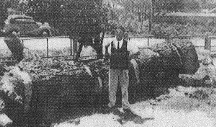
Mr. Osborne with the last pine tree in pieces
Mr. Warren had planted two pine trees at the front of the church. They soon grew into two beautiful trees, but as with pines, by 1922 they had started to take over the site. That year they were lopped, but then they lost their shape. By 1940 one still stood growing bigger each year. Debate raged as to whether to remove it or just lop it. Finally in 1952 the committee decided for its removal. Mr. Osborne was hired for £40 to remove it.
At the end of Rev. Peatt’s ministry, 1923, Heathcote was removed from the Helensburgh Provisional District and joined to a redrawn Sutherland parish. Over the years the Helensburgh ministers had relied on Lay Readers to service the Heathcote church and this was not the best way to minister to the church. By this time services were no longer held at Cawley and Lilyvale as both villages had all but disappeared. Darkes Forest had never had a great population so from time to time services were held there, but with little regularity. Otford continued to hold services in Mr. Lucas’ hall, made up of mixed denominations. Stanwell Park continued in much the same way, but a bit stronger.
Rev. David Creighton, 1924-1927
The eighth rector, Rev. David Creighton, was inducted to the parish in September 1924 by Archdeacon Boyce. With his wife Ruby they made quite an impact on the church. On November 18, 1924, the inaugural meeting of the Ladies Guild was held in the Rectory. The President was Mrs. Creighton, Vice Presidents Mrs. Smith and Mrs. Cox, Treasurer Mrs. Griffith and Secretary Mrs. Sutton, a position she held till she left the district in 1934. It was this group of ladies who organised social fund-raising activities for the years to come. The Ladies Guild replaced the smaller Ladies Parochial Committee which had the responsibility of running the annual Bazaar. The Bazaar, or Sale of Work, was usually held in the Empire Theatre and was great event in the life of the town. Some of the earlier ones went over three days. In the later years they were reduced to one day affairs in the Parish Hall. In 1925 the Bazaar raised $282, in 1929 it raised $232 and in 1930 it raised $176 (eighty eight pounds).
Rev. Reginald Gee, 1927-1928
In 1927 Rev. Reginald Gee became the new Curate in Charge of the Helensburgh Provisional District – the ninth minister. Six weeks before, he and his wife Ruth had been married. it was quite a shock to arrive at the Rectory to find its total contents consisted of one cast iron fuel stove. Thankfully they were provided with a new enameled one priced at seven pounds, seventeen shillings and three pence. So out of their $500 a year stipend they had to raise a loan and buy some new furnishings from the local Co-Op store.
As Chaplain of the Waterfall Consumptive Hospital the local minister received an extra $100. From this extra income Rev. Gee was able to buy a car, a second hand Citroen. The Parish provided thirty pounds extra for petrol. At one shilling and eight pence per gallon you could travel a long way on thirty pounds. The main mechanical repairs of the day were new springs regularly broken travelling the highway.
The Gees soon made a home for themselves in Helensburgh. Over the years ministers found that it was a friendly village as long as you didn’t put on airs. The only unfriendly element in the town was the small communist group who openly opposed any Christian activity.
Services continued at Waterfall 3pm, Darkes Forest and Otford 7pm week nights, Stanwell Park 3pm, and Helensburgh 8am, 11am, 7.15pm, with a children’s service once a month. Services were well attended. There was a choir with a number of Welsh singers in it. In 1927 there were 9 Confirmations. The Church Warden’s were Mr. Sutton, Mr. Stevenson, and Mr. Edmondson, who was also the Sunday School Superintendent. Other personalities in the church at the time were Dr. Cox and his wife, Mr. Pell a local miner and Mrs. Pell, Mr. and Mrs. Barrett, Mr. and Mrs. Hartley who owned one of the local dairy farms at Blue Gum, Mr. and Mrs. King, Mrs. Gray, Mr. Griffith a local miner and always recognizable in his bowler hat, Mrs. Griffith, the Prossers who owned the shop opposite the hardware shop and who always supplied the ham for the Sunday School Picnic, Mrs. Mills, Loomes, Mitchinson, Mr. Green a miner, and Mrs. Green, Mrs. Kinnell the organist, Mrs. Gwen Rae who as Miss. Gwen Griffith had played the organ for many years up till 1927, Mr. and Mrs. Stevenson (Mrs. Stevenson ran the Girl’s Club), Alan, Bill and Ella Sutton (Mrs. Sutton was the Guild secretary until the family moved to Bathurst), Mr. Burnett, Mr. Errington who gave many an hour scything the church grounds, Mr. and Mrs. Powell, Miss Short who was the central organiser of the many children’s concerts during the depression, Mr. and Mrs. Senior and Mr. and Mrs Wilkinson of Stanwell Park. Other families who attended church were the Fairbrothers, Alstons, Finneys, Illingsworth, Oldfields, Dentons, Thicketts and Pasfield. When the East family moved into the district and began attending, they took up a whole pew.
The Guild and Girls Club continued to thrive as before. The Parish Paper now had a circulation of over 300 copies per month. Rev. Gee involved himself in Cubs, Scouts and the local cricket team. He was a wicket keeper for the Helensburgh team and was able to install a sense of decorum on those occasions when the team was defeated. Visiting sporting teams were warned to get out of town quickly if they won the match as local team loyalty ran deep. As with ministers before, he was very friendly with the Catholic Priest, Presbyterian minister and the Methodist circuit rider.
The hall was now used for the Guild, Girls Club, Cubs, Scouts, Sunday School, The Rifle Club, and St. John’s Ambulance. Given its heavy use, plans were drawn up for a stage and kitchen extension and the replacement of the timber stumps with brick piers. The work was completed in 1928. It was the last major work for some time with the offertories cut in half by the depression. General maintenance continued. Also in 1928 new combination large print hymn and prayer books were purchased for those struggling to read the small print under the acetylene lamps. The unsettling affects of the depression in 1928 brought some new faces to town and so a social was run in the Church Hall to welcome the newcomers.
Up till 1928 The Stanwell Park Primary School had functioned in the front half of the church building, but now with the completion of the new Public School next door, church furniture was purchased as well as a new pedal organ from Mr. Bilby of Burwood for twenty five pounds. The actual building costs for the Stanwell Park Mission Church had never been fully met and so in lieu of payment the back section was rented out. Even after the debt was cleared the rear flat (later the church hall) was used as a source of revenue. Naturally there was the usual friction between the landlord and the tenant. On Good Friday 1928, the tenant decided to paint out the flat while the service was still underway. Of course, there was a scene. A new Australian family later moved into the flat, but the husband enjoyed a drink and after his Saturday evening drinking bouts there was the inevitable family brawl on Sunday morning. The tenant problem came to a head in 1934 when they refused to pay rent and were evicted. The room partitions were removed and the back section opened up to become the hall.
In the middle of 1928, Rev Gee was invited to the Parish of Nowra. It was a difficult time, Ruth had given birth to their first child, a boy, but she remained in hospital for four months after the birth. The rector had to pack and move without direction – furniture, cat and canary. The farewell party was a warm affair.
Rev. Walter Kennedy, 1928-1933
August 1928 Rev. Walter Kennedy was instituted to the Helensburgh Provision District by the then Rural Dean of Wollongong, Rev. Edward Walker. He was the tenth minister to serve the Parish. Rev. Kennedy was married without children. Within a few weeks of their moving in, the Rectory sported a strange antenna. The Rector was a Radio Ham, or as we would say today, a CB Freak. He was soon in contact with the town’s other enthusiasts Sam Morgan and Bill Potter.
The church now had to survive through the difficult years of the depression. In 1929 the Sale of Work brought in one hundred and sixteen pounds, but in 1930 only eighty eight pounds. Even so, a new harmonium was purchased in 1929 for seventy pounds. The money was raised by church members putting aside one shilling a week toward the new organ. In 1930 the buildings were again painted and the pews varnished. Actually, this turned into a disaster because they were still sticky on Sunday. Increasingly church members undertook any needed work around the property. Mr. Stevenson built the Church porch and the Rector’s garage during the mine’s slack periods. In 1931 a new side fence was installed using second-hand railway sleepers at one shilling each. In 1932 new windows and sashes were installed in the church, and Mr Smith undertook the repair of the Stanwell Park church roof. To cut down on costs, the paid church cleaner was laid off, the parish paper discontinued and there was even the suggestion of holding the evening service at 4pm to cut back on lighting costs.
Parish finances were greatly aided by the ladies in the District Visitors team. Mrs. Pell, Stevenson, Smith, Sutton and McKillop spent many an hour collecting pennies toward running costs. The ladies also arranged concerts, cantatas, community singing, stalls and special appeals. Two well remembered appeals were the 120 sixpences and the 500 shillings. There were, of course, the everyday traumas. The Scouts continued to break windows and even on one occasion got into the piano. This instrument had quite a history. It was the original school piano and had been bought by the church in 1914. It continued its service in the hall until it was replaced by a Pianola in the 1970s.
In 1929 white ants made their first appearance in the Stanwell Park Church. This was to be the beginning of a long battle that would see the end of the church buildings at Helensburgh and Waterfall. In 1935 the wooden piers under the Helensburgh church were replaced with brick piers to combat the threat. The major problem was that the porch built, in 1930, had been constructed over the stump of one of the pine trees. It became the nest and entry point for later white ant attacks. In 1947 white ants were discovered in the Waterfall church and quite a few studs replaced. Then in 1949 the floor was replaced. The same year ants were discovered in the west wall of the Helensburgh church. In 1952 the pest exterminators, Powell & Co., were called in, but they were unable to find the source of the problem at that time. In 1959 the east wall was replaced. Meanwhile, the Waterfall church was again under attack, but on inspection it was found that the building was now little more than a shell. The building was demolished in 1957 by the residents of Waterfall. They were invited to a church bonfire and Bar-B-Q to say farewell. All that remained were the pews, stored under the Bushfire Brigade station, and the church bell. The congregation continued to meet in private homes through to the 1980s.
Back at Helensburgh things were not much better. Mrs. Hammonds fell through the floor while cleaning the church, and one windy Sunday evening the service was transferred to the hall due to the precarious swaying of the building. On the 27th May 1962 Rev. Butler led the last service held in the original church building. The original Rectory, next to the church, was to face a similar end, being demolished later that same year. During the building of the new church (hall), Ken Hammonds was painting the joists and bearers with a mixture of arsenic and creosote and was heard to say “go on, have a go at this lot.”
Rev Kennedy, as with the ministers before him, used lay readers in the outlying centres. Messrs Kemp, Kennard, Edward and Grenville all gave a hand. Unlike the earlier years when lay readers from Sydney were employed, the church was now strong enough to use members of the congregation in this ministry.
Rev. Herbert George Robinson, 1933-1937
In 1933 Rev. Kennedy was invited to serve in St. Peter’s East Sydney and was replaced by Rev. Robinson in 1933 – the eleventh minister. He was inducted to the Provisional District on 13th June by the acting Dean Rev. Le Huray. Rev. Creighton was present at the service to welcome him to the Burgh. Rev. Robinson came with his wife Edith and son Reg. He soon gained a reputation for his preaching. One series on Genesis lasted for over a year. Edith’s great claim to fame was her cooking ability. Her fancy sweets at the annual fete were always sold up in the first hour.
Parish activities continued as usual: Services, G.F.S., Community Singing, Scouts, Women’s Guild, Ash Wednesday Scripture Service (109 present in 1936), Harvest Festival (corn for the pews courtesy of Mr. Hartley), etc. Maintenance continued with the church and hall repainted cream with brown trim by members of the congregation. The original 1925 church electric lights were getting a bit dull and so were replaced with 100 watt gas-filled lamp bulbs – such extravagance.
With the commencement of Woronora Dam and the establishment of a small community of workers on site, Rev. Robinson initiated church services in the site hall once a fortnight. Sunday School was moved from Sunday afternoon to a morning slot. A Tuesday evening Bible study was commenced. A number of open-air evangelistic services were held. In 1934 a whole week was devoted to mission. It consisted of Women’s meetings, children’s club after school and nightly evangelistic services. Attendances at the evening meetings ran at around 30.
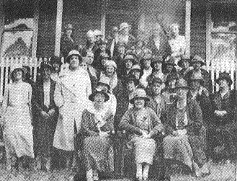
The Mother’s Union. Front row, left to right. Mrs. Robinson, Mrs. Cox. Mrs. Griffith.
In 1934 Mrs. Robinson formed a Mother’s Union group, a group which continued for many years. Mother’s Union was a women’s devotional group meeting once a month. The sister church for the Helensburgh group was Christ Church Rotherhithe, England. For many years, Mrs. Cox, who after Mrs. Robinson, became the group leader, corresponded with Miss M.J. Howell of Rotherhithe. She was at the time the leader of her local branch.
Life in the Rectory was made easier with the installation of a telephone in 1934 (Helensburgh 24, now 02 4294 1024. This is the second oldest Helensburgh telephone number still with the original owner. The Catholic church is the oldest). Prior to this the Rector used Dr. Cox’s telephone. The good doctor didn’t seem to mind. Dr. Cox was a great supporter of the church, even to baking fresh bread rolls on Sunday morning for the Rector’s breakfast. His home was two doors up from the Presbyterian church in Robertson St. One other event in 1934 should be recorded; the Rectory was burgled. The thief was never found.
Stanwell Park Mission church continued strongly. New pews were purchased in 1934 and assembled by the members. The pews were repadded in 1976 by Steve James. The Rector and local lay readers took the services. A church committee was formed, a women’s club started in 1934 and regular working bees held, ably fed by Mrs. Anger. Mrs. Moseley continued the tradition of a church garden party to aid church funds. The church garden party continued through the years with the last held at Mrs. Rivers’ home in 1976.
The Waterfall church continued to struggle. A lay reader was hired from Sydney to take services in 1935. In the same year, Mr. Childs, one of the most faithful members in the church, passed away. It was a great loss.
Rev. Henry Flores, 1937-1947
In 1937 Rev. Robinson was appointed to St. Silas Waterloo, but sadly was to die within a few years. Mrs. Robinson continued to visit her friends in the town right through to her old age. She would often stay with Mrs. Green. Rev. Flores was inducted as the new minister on 20th April 1937, by Archdeacon Johnstone. He was the twelfth minister to serve in the Burgh. Rev. Flores was married with two children, Alice and Laurence. He was Maltese and his wife was Irish and crippled. They were serving as missionaries in the wilds of Canada before coming to Helensburgh. Henry spoke with a broken accent and so was hard to understand. He was a real rough diamond, although highly educated.
Services continued as before: Helensburgh 8am, 11am and 7.15pm (later 7.00pm). Stanwell Park 9.30am or 3.00pm fortnightly. Waterfall, Otford and Woronora, 3.00pm once a month. The Woronora services ceased in 1941 with the completion of work. Mother’s Union, Women’s Guild, Girls Friendly Society, Choir, Sunday School, Bible Study and Children’s Concerts continued as before. The 1939 Bazaar was held over three days and raised eighty pounds. Sunday School picnics continued to be held at the Dummies. Confirmations were held yearly. In 1945 there were 25 candidates.
Finances remained a problem with the offertories totalling only two pounds ($4), an amount only just above the dole (unemployed social security). It was difficult to handle any major expenses. The Archbishop allocated ten pounds per year to finally purchase the church property from the Lands Department over five years. He also allocated forty pounds ($80) to the Stanwell Park mission church to repaint the church and build a front fence. Again it was the ladies to the rescue with Bazaars and collections (the District Visitors). One of the most faithful District Visitors was Miss Pasfield who retired from this work in 1941. She was well remembered for her Victorian dress, button up shoes and insisting ways. During the 40s an annual Temple Day was instituted to bolster finances.
The new Rector was an amateur printer and so he recommenced the Parish Paper in 1938. He also formed a Youth Fellowship which met on Friday nights in the church hall for games, etc. A number of Youth Services were held each year in conjunction with the club. A monthly adult social in the church hall was instituted and run by Mrs. Fairbrother. Missionary support remained strong: The Church Missionary Society, The Home Mission Society and Moore Theological College.
The war years now touched the church. Up went the “black out” paper over the church and hall windows. The Hall was converted into a First Aid Post and the centre for the Red Cross. Naturally there was a drain on man power and the inevitable loss of life. For instance, Mrs Green, a regular at church, was to lose her husband.
As the years went by new members joined the church and others left. For many years the Church Wardens had been Mr. Edmondson, Stevenson and Pell, but in 1938 the trio broke up when Mr. Edmondson retired and left the district. He was to die in 1939, greatly loved. The three had always sat on the right side of the church in the rear choir stall. A plaque was placed over Mr. Edmondson’s seat. Mr. Kinnell, his replacement Warden, never took over the seat out of respect for his colleague and friend. Mr. Alston, a member of the Parish Council, was also to die that year. He was involved in a traffic accident on the highway.
Some of the members of the Parish Council in the 40s were: Mr. Griffith, Mr. Basham who owned the Ampol service station, Mr. Hargraves, Mr. East, Mr. (Yorkie) Barrett a miner, Mr. Lee Styles who owned the Postmans Track store, Mr. Thickett who was later to go blind, Mr. Rutter, Mr. Simpson, Mr. Geoff Cox, Mr. Hammonds and Mr. Hindmarsh. Mrs. Kinnell continued to pedal away at the organ. Mrs. Cox ran the Mother’s Union, and was secretary to the Ladies Guild. Mrs. Pell and Mrs. Kinnell faithfully cleaned the church together each week. Workers for the 1946 Bazaar were Messes Flores, Pell, Gash, Weaver, Kinnell, Stevenson, Duffy, Cook and Hargraves. Mrs. Stanford continued to work her magic creating costumes for the Children’s Concerts. Some of the families attending church at this time were: Rutter, Hammonds, Dunne, Hickling, Walton, Smith, Finney, Thickett, Basham, Hargraves, East, Barrett, Styles, Hindmarsh and Fairbrother. The District Visitors were Mrs. Stevenson, Mrs. Pell and Miss Pasfield. Some of the members of Girl’s Friendly Society were: Joan Weaver, Alice Flores, Mavis Kinnell and Ilma Roser. Leading lights in the Otford congregation were Mr. & Mrs. Bean. At Stanwell Park the wardens were Mr. Hickling and Mr. Rutter. Some of the families attending were: Surtees, Hulme, Anger, Rutters and Fehrenbach. Leading lights in the Waterfall congregation were: Messes Mason, Wilson and Murray. Mrs. Murray ran the Ladies Guild.
At Stanwell Park the southerly busters continued to cause trouble. In 1935 major foundation and roof damage was caused by a howling gale. The “wings” had to be reconstructed and strengthened. Another gale in 1945 undid much of this earlier work. It was so bad it actually blew the two church lavatories away. At Helensburgh the hall was given a refit in 1938 with the addition of new curtains made by the Women’s guild for a cost of two pounds ($4) and 60 used wooden seats from the Empire Theatre for a cost of 1/- each. They replaced a number of very uncomfortable forms. The Empire had gone modern and refitted with metal framed cushioned seats. When the Empire closed the church acquired a number of these seats to replace the wooden ones. For years later youth leaders would struggle to remove children’s legs from the back of these seats when they flipped up after a child walked on them.
1942 was the 50th Anniversary of the Church of the Holy Redeemer. It was celebrated with a special Sunday service and a social on the Monday night. Another very special service was held in the church on 19th August 1945. It was “Victory Sunday”. A service of thanksgiving was held to celebrate the end of the War. It was a full house.
Rev. Charles Martin Rogerson, 1947-1949
In 1945 Rev. and Mrs. Flores left Helensburgh after serving the longest term yet of any minister. He was replaced by Rev. Rogerson, the thirteenth minister. He was blind and read the services and the scriptures using braille. With his wife Dorothy he soon settled into the Rectory. Obviously, he had great difficulty visiting around the town and so for the first year Mr. Barret drove him on visitation. The rectory was repainted for their arrival and in 1948 a new electric stove installed.
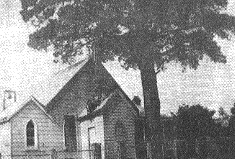
The pattern of Church life continued as usual. Sunday School since its inception had gone through a number of ups and downs, yet it was viewed as “the Church of tomorrow” and therefore an important part of the church’s life. Superintendents such as Mr. Edmondson (1920s-30s), Mrs. Stevenson (1940s-50s), Mrs. East (late 1950s), John Boughton (1960s), Ambassadors, Mr. Sweeney, Mrs. Hammonds, Glenys Warner….. all worked for the gospel. The 30 year service of Mrs. Stevenson was a wonderful testimony. Each centre would have a yearly picnic and Christmas party with prize giving. In 1947 the Helensburgh picnic was held at the Park with the typical sack races, egg and spoon races, and all with the first prize of 1/-. For the Christmas party the hall would be decked out by the children in anticipation of the grand day. In 1948 the Waterfall Christmas party and prize giving was attended by most the village, with Mr. LeCler performing as Santa Claus.
The music in the church was directed by Mrs. Kinnell. On her retirement, the music was left in the hands of Mrs. Jeffries, then Edwina Brooks, Marilyn Moir in the 1980s and Jeff Lee in the late 90s. The church music was aided by a boys’ choir in the morning and an adult choir at Evensong. The small room at the back of the hall on the right side was used as a choir vestry. The hymn book used in the church was The Hymnal Companion. This was later replaced by Hymns Ancient and Modern during Rev. Bill Twine’s time, then Hymns for Today’s Church in the 1980s, and now mainly choruses with overhead projector. In the early days Alexander’s Hymns were used by the Youth Fellowship, G.F.S and on evangelistic occasions.
Church finances remained a problem and so the church continued to receive a grant from H.M.S. to the tune of one hundred pounds ($200) per year. The District Visitors, Mrs. Pell, Stevenson and Rutter continued their work of bolstering church funds. Once Mrs. Stevenson raised forty five pounds ($90) and was awarded a new pair of shoes for her sterling effort. Maintenance continued as an ongoing problem. In 1947 the Stanwell Park Mission church was repainted and extra light installed. A bell was added to the building at a cost of two pounds and fifteen shillings ($5.50). Mrs. Murray also donated a secondhand organ for use in the services.
Sadly, Mr. Pell, who had served as Church Warden for over 40 years died on 26th December 1947. He was remembered by the congregation in the commissioning of a stained glass window installed by Mr. Stevenson, Styles and Weaver. The same year Mr. Kinnell retired as Church Warden owing to ill health. He had served for 10 years.
A number of innovations were attempted to bolster numbers – Lantern slide evenings for the men and American teas for the ladies. A church ball was planned, but after investigation by Geoff Cox it was decided that there was not enough support for the idea. A social tennis club was planned and to this end the next block of land up from the Rectory was purchased in 1948 for thirty three pounds ($66) on a ten pound deposit. The court was never built and the block was eventually used to build the new Rectory in mid 1980s.
The Otford congregation at this time remained small, but strong. Mr. Lucas in 1948 offered the Parish a block of land for a church. A fund was started and within a year twelve pounds was raised, but the congregation did not go on with the venture. When Mr. Lucas died in 1955 he left the particular block of land to the church as a bequest. It was situated on the lower side of the Otford Public School. Sadly the land was later sold by the Parish and the money placed in trust. The reasons for the sale were the demise of the Otford congregation in the early 1960s, the excessive slope of the land and the crippling rates.
Rev. Percy William George Twine, 1949-1954
Rev. Rogerson found it extremely difficult to carry on his ministry around the undeveloped streets of Helensburgh and so accepted an appointment to Erskineville in 1949. He was followed by Rev. Bill Twine, known affectionately as Dollar Bill, with his wife Joan. He was the fourteenth minister. He came straight from college to Helensburgh.
Rev. Bill Twine was a distinctive person. He was high church in his leanings and so took the congregation upward in churchmanship. He could be seen walking around town with homburg and cane. The cane, he said, was to keep the children at bay. When in the 1950s he purchased a car, it was a sports car, a doorless Singer, not the most reliable car around, yet he said all you had to do when it broke down was to stand next to it and look hopeless. It always worked. The next car was a De La Salle, wiped out in an accident, and was followed by an Armstrong Sidley renowned for lack of power. Bill was a jovial fellow with a great sense of humour. On one working bee he passed around glasses of communion wine with the quip, “If Father Scanlen can give his worker beer I don’t see why I shouldn’t give you a sip of the Lord’s wine.” Of course, his pranks did put some people offside.
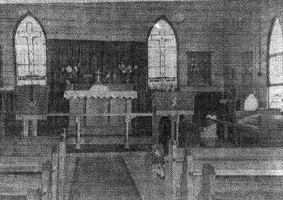
Rev Twine’s nickname came about by his fund-raising activities. When he played the piano for the opening of the bowling club, the hat was passed around and he was able to hand over one hundred pounds toward church funds. In 1951 the offertories were four pounds a week, by 1953 they were eight pounds. Under Bill the church was able to fund itself in 1952 without H.M.S. assistance. Now able to meet its own financial commitments the Parish was declared a Parochial District.
Rev. Twine was an innovator. After the morning services he would give organ recitals. He obtained an amplified carillon and played it before the services. He ran numerous special services for the Scouts, CWA, School Parades, Red Cross, etc. He loved the theatre and organised visits from theatrical groups and choirs to perform at the Empire Theatre. Mr. Downie donated the theatre for Church activities. Rev. Twine formed the Helensburgh Anglican Recreation Club, the main activity of which was Table Tennis. Then there was the Anglican Literature and Musical Society. Bill’s rendering of ghost stories were remembered for many years. Then there was the Orchestra, Church Ball and the Dramatic Society.
The Dramatic Society mainly performed one act plays in the Church Hall which was now fitted out with an array of sophisticated sound and stage equipment. The highlight of these performances was ‘The Pageant for Elizabeth’ held in the Empire theatre to mark the coronation of the Queen in 1952. The Pageant was written by Ken Barrett, the music arranged by Bill Twine who conducted the orchestra and choir. Some of the personalities in the dramatic society were Georgina, Alex and George Simpson, Elinor Stevenson, Edith Marshall, Peg and Les Stuart, Rita Greenaway, Rona Powell, Edythe Fairbrother, Ellen Hindmarsh, Joan Taylor, Alice and Humphrey Osborne, Violet Drysdale, Lawrence Hill, Ennis Fairbairn, Lillian Newman, Helen Green and Geoff Cox.
Bill Twine was High Church so he liked a little colour in the service. He formed a Servers Guild which continued till he left the Parish. He was renowned for his short sermons, some even less than 5 minutes.
In 1950 the three services at Helensburgh were reduced to two, 9.00am and 7.15pm. Stanwell Park was increased to a weekly 3.00 pm Sunday Service. Waterfall and Otford continued at once a month. In 1951 monthly services were commenced at the home of Mr. & Mrs. Steele at Stanwell Tops. This service did not continue for long. The Parish Paper continued with a distribution of 200. Temple Day (fete) raised $80 in 1952. The tennis club continued to play at Ramsay’s court, Mr. Simpson acting as the secretary. Women’s Guild, Mother’s Union, etc. continued as before.
In 1951 there was a move to again include Heathcote in the Helensburgh provisional district, but this was opposed by Sutherland and so the transfer didn’t go ahead.
Sadly a number of old identities passed on during Bill Twine’s period of ministry. Mr. Stevenson, the last of the three original Church Warden’s died in 1949. Mr. Kinnell, who had replaced Mr. Edmondson as warden, died in 1951. Two old faithfuls, Mrs. Betts and Mr. Warren, also died in 1953. The new church wardens were Mr. L. East, Mr. G. Cox and Mr. K. Hammonds. Rev. Flores, well known to a small group of friends in the town, died in 1953. A memorial service was held for him in the church.
In memory of Mr. Stevenson a fund was started to buy a new organ. The original organ had been fitted with a blower in 1949, but Rev. Twine encouraged the purchase of a second hand pipe organ. After raising some $400 Bill set to and built the organ which was dedicated in 1950. It was a bit of a hybrid, with the electronics powered by two six volt car batteries. When Bill left there was no one with the expertise to service the organ and so it was sold in 1955. It was replaced by a harmonium, still in the Helensburgh Anglican church until 2006, dedicated to Mrs. Kinnell. Also at this time a font was dedicated in memory of Dr. Cox in 1952, donated by Mrs. Cox. A Chalice and Patten was donated to the church in 1951 by Mr. & Mrs. Weaver.
Maintenance problems continued. Some $600 was spent on renovating the rectory. The church continued to sag through borer attack and so in 1951 a building fund was commenced. It was proposed to build a new church on the third block, the future tennis court site. Rev. Twine suggested it be built on a concrete slab to keep the borers away. The funds were slow in coming in so, in the meantime, the congregation set about restoring the existing church building. Powell and Co were called in to exterminate the white ants, the west wall was replaced and Mr. East sanded the floor. The pews were varnished and the building painted. The Waterfall church was going through similar problems and so Jack Atkins and Neal Murray replaced the floor boards.
The Stanwell Park church was holding up quite well during this period of time. Services were now once a week and the Sunday School was strong. There was a social programme and fund raising activities – sale of work, fancy dress concert… In 1949 a brass cross was purchased by Rev. Twine for the church. The cross is still on the Holy Table today.
Bill Twine left his mark on the Helensburgh district and many in the congregation and the town were sad to see him go. He was invited to become the minister at Bankstown, a position he held up till his death. A large contingent from Helensburgh were present at his induction.
Rev. David Hayes 1954-1955
Rev. Ashcroft filled in until the appointment of the new rector, Rev. David Hayes. He was instituted to the Provisional Parish in 1954 by Rev. Begbie, Archdeacon of Camden. His stay was a short one due to family problems.
Services continued as usual with an increase at Helensburgh, 8.00am, 11.00am and 7.15pm. The organisations continued as usual: Mothers’ Union, Sunday School, GFS, Bible Study…..
Sadly the white ants continued their work and complaints to the exterminators brought no response. The old vestry was altered and turned into a Baptistry in 1954 and repairs on the building continued. Old Mr. Barrett had died and Mrs. Barrett gave a pair of candlesticks in his memory in 1954. The candlesticks stood on the credence table, but as the churchmanship had moved downward, they were never used.
Identities of the time are as follows: Church Committee members, Mrs. Coffee, Stevenson, Weaver, Pell, Fairbairn, Kinnell, Hindmarsh, Dennett and Green, and Mr. Coffee the station master, Geoff Cox, Mr. Williams who owned the Park store, Mr. Steele of Stanwell Tops who ran a Sunday School in his home. Mr Styles who owned the store in Postman’s Track, Mr. Hammonds a Tech. teacher, Mr. Short who worked for the railways at the Metropolitan Signal Box, and Mr. Murray of Otford. Church Wardens were Mr. Styles, East and Hammonds. The Mothers’ Union had 15 members in 1957, Mrs. East, Hindmarsh, Pell, Hammonds, Stevenson, Coffee and Green. The Sunday School was still run by Mrs. Stevenson, although she retired in 1955, handing over to Mrs. East and Mr. McMaker. Other identities in the church were Mrs. Smith, Mrs. Bell, Mr. Mitchell, Mr. & Mrs. Taylor, Miss Illingworth , Miss Nell Stevenson, Mr. & Mrs. Fairbrother, Mrs. Luck, George Barrett, Mr. & Mrs. Greenaway. The Woman’s Guild was run by Mrs. Coffee. GFS was led by Mrs. Coffee, East and Luck. CEBS was run by Kevin Sims. The Table Tennis club was led by Harry Short. Organists were Mrs. Kinnell and Mrs. East. Caretaking under the watchful eye of Mrs. Pell. At Otford the regulars were Mrs. Hamilton, Mr. & Mrs. Murray, Mrs. Vardey, and Mrs. Schubert. At Waterfall, Mr. Jackson was the leading light.
Rev. Herbert William Robey, 1955-1957
Herb Robey, with his wife and three children Paul, Philip and Rosemary, became the next Curate in Charge of the Provisional district of Helensburgh. He was instituted in February 1955 by Archdeacon Begbie. Twelve ministers were present, including the local Presbyterian and Methodist ministers.
Herb was a strong Evangelical and a systematic Bible teacher. His main hobby, bicycle racing, stood him in good stead for the local Helensburgh races. The circuit around Parkes St, Walker St, Lawrence Hargrave Drive and the Princess Highway was the regular race track, but increased use of the highway caused the suspension of the races. Herb had served in WW2 and then entered the printing trade. He had been an active trade unionist and so stood well with the miners. He was 38 when he left Moore College and came to Helensburgh.
The congregation under Rev. Robey concentrated on getting the Gospel out into the district. To this end the Sunday School at Otford was revived. Mr. Steele expanded the Sunday School at Stanwell Tops. At Helensburgh Herb started a small bus run picking up the children from West Helensburgh, the Nissen Huts and the Housing Commission. A student deaconess, Miss Hepper, was hired for visitation work in 1955, and two missions in 1956 and 57. Don Robinson of Moore Theological College led the first mission team of students. Week-long services and meetings were held with the students visiting the town and outlying centres. The second mission in May 1957 was also carried out by Moore College students and this time led by Owen Dykes. It was part of a large South Coast mission. Local activities and visiting culminated with a final mission meeting at the Wollongong Town Hall where Bernie Gook spoke. The students were billeted out during their stay in Helensburgh.
The church finances again went into decline. Only half the expenditure was supplied by offertories which were around $8 per week. The 1955 fete raised $200 with the kitchen stall run by Mrs. Green and Mrs. Kinnell raising seventeen pounds 7/9 ($34.78). Even an HMS grant of $200 didn’t help to meet the deficit. Even so the deteriorating condition of the church building prompted the establishment of another building fund in 1956 with Mrs. Cox’s mile of threepences. The fund grew despite all the financial troubles. Even the mission societies continued to be supported. The attendances at Helensburgh indicated the state of the problem. The 7.15pm service was so badly attended that on some evenings no one was present. In 1957 the services were again reduced to two, 11.15am and 7.15pm.
In 1956 Mrs. Stevenson, after so many devoted years to the Sunday School, finally resigned. Also during this period some of the old identities passed away. Mr. & Mrs. Thickett who had retired to Stanwell Park, and Mr. & Mrs. Rusfeldt. A Communion Cloth was crocheted by Miss Short in memory of Mrs. Thickett. It was dedicated in September 1957 by Rev. Feltham of Austinmer. In the same year Mr. & Mrs. Styles left for Queensland. Mr. Styles was a faithful member, as was Mrs. Styles to the Roman church. They were greatly missed.
Herb and his family were invited by the Archbishop to accept an appointment to Riverstone and to take up his duties there at the beginning of June 1957. Herb was to have a long and faithful ministry, serving with great distinction in the Brisbane diocese and retiring in Canberra.
Rev. Thomas William Butler, 1958-1962
The financial situation now facing the district prompted a review of the situation at head office. In the meantime the Waterfall Church came to its fiery end. After a full examination of finances it was decided to incorporate the Helensburgh district, other than Stanwell Park which was placed with Austinmer, into the new Provisional District of Engadine. Tom Butler with his wife and children Ruth and Ann came to Helensburgh in 1958. His background of strict, austere Protestantism in South Africa made it difficult for him to relate to easy going Australians. A new rectory was purchased in Engadine in 1959 and soon the old Helensburgh rectory was abandoned. Helensburgh and Waterfall received only limited representation on the new Parish Council. It was all a natural consequence of the decline of the Helensburgh district and the new housing boom at Engadine.
The services at Helensburgh were soon reduced from two to one. They alternated between 11am and 7.15pm. Numbers attending were now about 40, but they were on the decline. Children’s Concerts, Socials, GFS and CEBS all closed, although the other church groups and activities continued as usual. In 1961 the fete was held in the RSL hall.
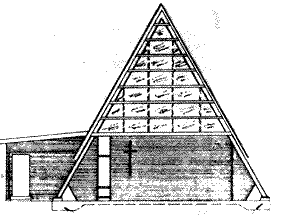
The main project facing the Helensburgh church was the condition of the church building. Little could now be done to save it. The building fund in 1960 had reached over $1,200. Money boxes were distributed throughout the town and support for a new building remained strong. In 1961 a sub-committee was formed to investigate building plans and ideas were circulated amongst the congregation. Thank heavens that one plan for a concrete block building was never accepted. In 1962 the Archbishop was approached for permission to demolish the church.
In the face of these growing difficulties the congregation retained its sense of community. In 1960 a special thanksgiving tea was held for the remaining three faithfuls: Mrs. Cox, Mrs. Stevenson, and Mrs. Pell. In 1962 Mrs. Kinnell the church organist was remembered in a presentation to her from the congregation.
Maintenance of the church property continued under the watchful eye of Ken Hammonds. Fire damage to the rectory was repaired, new curtains placed in the hall and the third block cleared. In 1960 the Broughtons moved into the rectory. John, a teacher, was soon involved in Sunday school and later served as a lay reader and committee member. He also took a leading role in church youth work and the scouts.
A youth group had developed during Herb Robey’s time and struggled through to around 1960. The Presbyterians and the Methodists also had struggling groups. The kids themselves decided to form a united fellowship and from that time on the group flourished. Margaret Senescall was the leader at the time of the union and Narelle Sellar became the leader and continued until she left for Bible College in the mid ’60s. Ambassadors, an American based youth Evangelism group, had purchased land at Stanwell Tops and built in 1962. The site is now owned by the Church of Christ and used for conferences. Staff became very much involved in the Helensburgh youth group, especially Reg Locke and Rodger Warner. The group held regular camps, socials and outings to youth rallys. Meetings were held on Sunday evenings and consisted of chorus singing, prayers, Bible readings and a speaker. Some of the leading lights were Rhonda Smith, Irene and Glenda Perry, Shirly Sims, Lyn Gash, Edwina Adlington, Bronwyn and David Senescall, Bill, Caroyln and Lee Werry, Cheryl Loudon, Barbara Coffee, Paul and Derek Sanders…. The group folded in the late ’60s as the older members left to get married, etc. A solid group of committed believers emerged from the group and are members of the local churches today.
Services at Waterfall continued monthly in private homes, but were now controlled from Engadine. Services at Otford ceased in 1962, the land for a new church was held in trust, but the building fund ceased.

Stanwell Park continued strongly. Services were held weekly at 11am with a 10am family service once a month. Attendances were around the 30 mark. Now with Austinmer, the Park congregation continued to develop a strong independent streak, threatening at times to run the show by themselves. Finances were on the up. Offertories in 1947 were $200 per annum. In 1960 $250, 1964 $640. The ladies ran an annual sale and street stalls raising $220 in 1965. The bottle and scrap drive raised $160 in 1965 toward the building fund. This fund commenced in 1964 with the sale of 1/- brick cards. By the end of the year some $800 had been raised toward the fund, with a total of $3,400 held in kitty by 1967. The fund sought to extend the existing building to increase the worship area and the rear hall area. The existing building was still in good shape and widely used by the local community. The school would periodically use the rear hall for a class room and the worship area was even used as a doctors surgery for a time. The roof was resheeted in 1963 after a massive hailstorm. In 1958 the wardens were E.L. Murray, Norm O’Brien and Arthur Short. Sunday School teachers in 1961 were Mr. & Mrs. Collins, Miss Anger, Miss Davies and Miss Chappel. Other identities were Mr. & Mrs. Water who left in 1963, Miss Potter, Mr. Adams, Miss Murray the organist, Mrs. Anger, Mr. & Mrs. Chappell, Mrs. Kemp and Mrs. O’Brien (later the Church secretary), Miss Judith Short who later led the Sunday School and played the organ, Miss Potter, Miss Shore, Mrs. Stephens, Mrs. Wallace, Mrs. Adams, Mrs. Fairweather, Mrs. Watmuff, Mrs. Orton, Mrs. Oliver, Mrs. Shubert, Mr. & Mrs. Rutter, Mr. & Mrs. Hickling, Mrs. Rivers.
Rev. Allan Laing, 1962-1963
Rev. Butler had led the church through a difficult period of transition. He resigned in 1962 and entered chaplaincy work. The new Curate in Charge of the Provisional District of Engadine with Heathcote was Rev. Allan Laing who set up home in Engadine with his wife. They were to stay about a year, for in 1963 they left for missionary service, but sadly were forced to return owing to ill health.
Services at Helensburgh now alternated between 8am and 11am with a family service once a month. Attendance was around 30. Mother’s Union and Guild continued as usual. The main preoccupation was the replacement of the church building. The plans were prepared by Bob Coffee and Mr. Pittard, with the final drawings accepted by the Diocesan architectural committee. The estimated cost of construction by Crusade Constructions was $9,300. Offers of aid came from all directions. Rex Jackson, the local member for the NSW parliament, arranged discount timber and cheap concrete blocks. Townsfolk volunteered their services for the building work. The building fund established in 1963 had now reached $1,500 and was moving ahead with donations from all quarters. Even the Mothers Union in Rotherhithe England sent a gift. The Parish roll prepared and supervised by Geoff Cox served to circulate building fund money boxes to help toward the project. The position of the new building sparked some debate, but the existing church site was chosen over the higher 3rd block site.
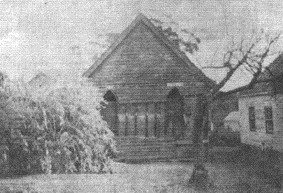
The Archbishop granted permission to demolish the church and hold services in the hall and so the inevitable day grew closer. To mark the end of the old church, past ministers were invited back to preach. Rev. Gee May 6, Rev. Bill Twine May 13, and Rev. Butler May 27, 1962. This was to be the last service in the old church. Over the following months the building was demolished by voluntary labour and the timber sold. The hall was given a clean up, the stage painted by Geoff Cox and Bob Coffee and the church furniture moved in on Saturday June 1. The services continued as usual.
Sadly the Rectory was also falling down. White ants were again the culprit. Demolition began on June 15, 1963, under the direction of Ken Hammonds. Materials and garage were sold off. Plans for a new rectory were drawn up by Crusade Constructions and a quote for a the building presented at $3,126.
John Boughton in May gained a promotion and had to leave his teaching position at Helensburgh Public and the district. The Boughtons, since coming to Helensburgh, had become deeply involved in the life of the congregation. John, in particular, serving as a lay reader in the church. Over 120 townsfolk attended their farewell on May 5, 1963. Thankfully Les Werry filled the breach and took over leadership of the services.
Rev. Fred Buchanan, 1964-1967
Rev. Fred Buchanan and his wife, became the new Curate in Charge of the Provisional district of Engadine with Heathcote. Fred was a popular bloke and a useful handyman at working bees.
The finances at the Helensburgh church were now at rock bottom. Sunday attendance was down to 25. It was clear to see that the planned new church was beyond the congregation’s finances. There was also little hope of building a new rectory. In a great act of generosity, Ambassadors offered to build a hall on the old church site similar to their hall at the Stanwell Tops Conference Centre. The cost was set at $2,500 and was eagerly accepted by the congregation. Building work commenced in July 1965. The plan was to build the new church on the rectory site some time in the future. The new hall would serve as a church in the interim. To this day this hall is still used as the church.
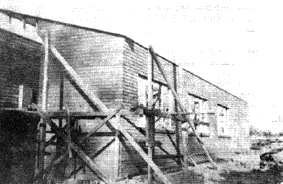
Allan Johnson directed the building with Reg Locke and Roger Warner giving a helping hand. Ken Hammonds, a first-rate welder, prefabricated the trusses. A partition was put at the end of the hall for a vestry and small hall and the entrance opening at the side of the porch, otherwise the design followed exactly the Ambassadors hall. The diocese approved the new hall for church services until the erection of a new church. The building was finished in September for an all up cost of $3,252. It was dedicated on October 17, 1965, a typical Helensburgh wet and windy day. The building was financed from the Building Fund and a $1,500 loan. Even with the fete, jumble sales, street stalls and special gifts, it was just possible to pay the interest on the loan, but no capital repayments. In 1966 IXL tin money boxes were issued to raise funds to meet the loan. New pews were given as memorials by church members for the new church. The original Communion Table, rails, Lectern, Pulpit, Reading Desk and Credence table continued in use.
Church organisations continued as usual. The Sunday School had 50 children attending, Mothers Union 15. Only the old hall remained a maintenance headache. In 1966 half the windows were broken by vandals. With the closing of the Empire theatre, the church was able to buy some of the old seats. Until they were dumped in 1977, they remained a continuing threat to life and limb as children constantly found themselves trapped in the folding seat. They weren’t designed to be walked on. Extracting the victim was always a delicate business. Fifth Sunday combined Protestant evening services were now held in the RSL hall. Some evening guest services were planned as outreach occasions, but were not well attended. The Church Wardens in 1966 were Les Coffee, Geoff Cox and Ken Hammonds.

In 1964, the Parish boundaries were again altered and Stanwell Park was included in the Engadine with Heathcote district. This made it possible to engage a Curate (an assistant minister) to cover the Southern section of the Parish. A flat was obtained at Stanwell park and later, in 1965, a renovated Igloo was purchased on the corner of Walker and Francis Sts to serve as the Curate’s cottage. The Curates were young men fresh out of theological college in their first or second training posting. Their term was about two years. The first Curate was Garry Child, he was followed by Warwick Thomas, Peter Tasker and his wife Joan, Trevor Middleton and his wife Jill, Don Wilson and his wife Libby, and finally Bryan Findlayson and his wife Doreen.
St. George’s Stanwell Park was now a very strong and independent church. Attendance was around 40, with the Women’s Fellowship and Sunday School vital organisations. In 1965 Mr. & Mrs. Short left the Park for Mowell Village. They had been spiritual lights in the congregation over many years. They left a fine memorial Communion Table of Queensland Maple as a parting gift to the congregation. On the maintenance side, in 1967 the church was lined and painted. The Wardens in 1966 were Mr. A. Quick, Norm O’Brien and J. Adams. In 1964 the church held a Jubilee Anniversary service with an overflow congregation.
Rev. Grahame Hynard, 1967-1978
Rev. Grahame Hynard with his wife Beryl and three children, became the new minister of the Engadine with Heathcote Provisional District, and remained so until the reformation of the Provisional District of Helensburgh with Stanwell Park in 1978.
During this period the Helensburgh church began to stabilise and finally, grow. The Sunday school of some 40 children was run by Mr. & Mrs. Sweeney, Mrs. Foster, Mrs. Hammonds, Rodger & Glenys Warner. Mothers Union was led by Mrs. Higgins, and the Guild by Mrs. Luck. The services continued weekly, led by the Curate. Scripture was in the hands of the Curate, Mrs. Luck and others, with Rodger Warner taking Otford. Maintenance, Ken Hammonds and John Rands. Ground-care, Bill Sweeney. Organist, Mrs. Mills of Otford and Mrs. Piper, and later, Edwina Brooks and Dulcie Jeffries. Church Wardens during this time were Bill Sweeney, Geoff Cox, Ken Hammonds and Mr. Coffee. The Parish Paper, “The Vision”, continued. Missionary support remained strong. Monthly Family Services and Anniversary Services continued, although not well attended. The Tuesday evening Bible Study group continued throughout this period. Brownies and Guides continued to use the hall until the construction of their own Guide hall. The Church ladies started an after school primary youth club. This ran from 1974 through to 1977.
As the 70’s progressed, the Sydney suburban push began to touch Helensburgh and some young marrieds from the Shire began to attend – Jeff & Jan Lee, Colin & Narelle Adams. At the same time some of the old faithfuls were to leave or pass away. Les Werry left Ambassadors in 1970, Rodger and Glenys Warner left for full time ministry in Queensland. Mrs. Green, Mr. & Mrs. Don Johnson and Mr. & Mrs Fairclough, and later Mrs. Jefferies were to leave the congregation. Those who passed away included Mr. Coffee, Mrs. Draper, Mrs. Cox and Joyce Illingworth.
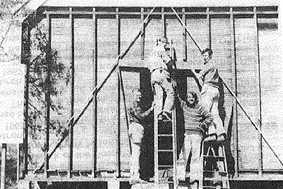
Repairing the old hall. L-R. Ken Hammonds, Rodger Warner, Bryan Findlayson, Colin Adams.
On the maintenance front work continued on the 3rd block. It was partly cleared in 1972 and Ken Hammonds made an interesting find of a plot of Marijuana. In 1974 Mr. Fairclough organised the mine bulldozer to clear the land and lay down coalwash. Bernard Price, over many years, slowly turfed the land and then mowed it. The hall roof was partly destroyed by a storm in 1975 and had to be replaced, as well as the front of the hall, along with new doors and windows. The new church needed little upkeep. Ken Hammonds put rails on the porch steps in 1968 and heaters were added in 1971. Hail damage in 1976 involved replacing a number of roof sheets.
The Stanwell Park continued strongly. Some new faces joined the crew: Mr. & Mrs. Irvine who were the new caretakers at Hillcrest. Mr. Irvine led a weekly Bible Study in his home and both were involved in the Sunday School. Mr. & Mrs. Ryan, both becoming totally involved in the life of the congregation. Mr. & Mrs. Thode. Mr. Thode was an accomplished church organist and his skills were quickly put to work. Miss Denalda Harris, Miss Kinnish, Mr. & Mrs. Rose, Mrs. Garnon, Mr. & Mrs. Bartlem, Ann and Steve James, Chris and Judith Lambkin, Reg & Carol Lobb, Ray and Marie Tinker. There were inevitably some losses. Mr. Adams, Mrs. Kemp and Mrs. Murray were to die. Miss Potter left to serve on the mission field.

Progress on the new building project at the Park was painstakingly slow. Sketches had been drawn but no final plan resolved. The building of the new church complex at Engadine was taking up most of Grahame Hynards time, but finally in 1970 a draft plan was presented and approved by the Parish Council. It proposed to turn the existing building into a multi purpose hall and church by extending the existing building down the block. Over the next seven years no step was taken to commence the project. Finances for the project were in hand. In 1971 the building fund had reached $4,830, and by 1977 it totalled around $10,000. The problem was that building costs continued to outstrip the fund’s growth.
Services at the Park alternated weekly between 8am and 11am. Sunday school numbered around 20, led by Miss Bartlett, Mr. Fairweather, Mrs. Anger and Mrs. Shubert. Later Mr. & Mrs. Irvine took over leadership and Mrs. Ryan and Judith Short took over in 1973. In 1976 Judith Lambkin, Steve James and Ray Tinker took the lead, and later Carol Lobb. Mrs. Rivers continued to hold her ever popular Garden Party. The Women’s Fellowship worked to raise funds. Their 1972 fete at the CWA Hall raised $220. Mrs. Orton won the chocolate cake competition and Mrs. Murray ran her renowned second hand stall. A Friday evening youth group flourished during Trevor Middleton’s time. There were about 15 in the group. On one occasion Trevor even had the group hike from the Park to the Burgh for supper. Maintenance continued as usual. In 1971 all the brassware was stolen from the church and was kindly replaced by the Anger and Short families.
Both the Helensburgh and Stanwell Park churches dreamed of the day when they could have their own minister again. This was frustrated by poor finances. In 1970 the Helensburgh offertories were $20 per week. In 1975 they were $30. By 1977, with the influx of young families into Helensburgh and Stanwell Park, financial independence became a possibility. The Archbishop was approached by Colin Adams, supported by Steve James, to see if it was at all possible to created a new district. Subsequent investigation proved the new district was viable and with the support of a $3,000 HMS grant the new district of Helensburgh with Stanwell Park was formed with Rev. Bryan Findlayson the new Curate in charge.
Rev. Bryan Findlayson, 1978-89
Bryan Findlayson, with his wife Doreen and children, Marelle, Paul and Justyne, was appointed as Minister in charge of the new district by Archdeacon Harry Goodhew, on March 3, 1978. There were some doubts that the district would survive financially. Sacrificial giving by the two congregations overcome any problems. In 1978 combined offertories were $8,000. By 1981 the offertories reached $16,000.
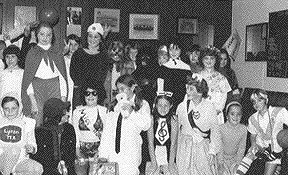
A youth work was commenced. Junior Club led by Steve and Anne James and Ray Tinker, commenced at the Stanwell Park Surf Club, 3rd term, 1977. It attracted some 90% of the Stanwell Park senior primary children. This was extended to a senior group and a youth fellowship at Ray Tinkers home on Sunday evenings. At Helensburgh a Friday night junior high school club got underway with the name, The Jesus Light and Power Co. By 1981 the old hall was decked out with 3 pin ball machines, a video twin racer, pool table, table tennis, shop and coffee tables. A Junior Burghers club was commenced as an after school activity on Wednesdays during school term. Numbers were in the 50s and it was an all out effort for the dedicated team of leaders. A senior high group, “Reunion Blues” functioned for graduates of the Jesus Light and Power Co. Transport was via 50 seat buses owned by the youth clubs. Two buses later, John Onames, the local bus company proprietor, loaned us his buses. Sadly, even one of these blew up while on a club outing.
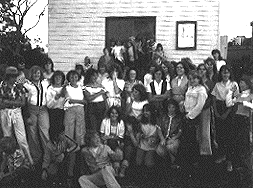
The Parish paper “The Messenger” was recommenced and Bryan prepared monthly articles in the Park Parade called “Just a Moment”. Both churches were involved in the 1979 Billy Graham crusade. In 1980 Steve James and Ray Tinker transformed the annual Carols by candlelight into a Christmas “Spectacular” with junior choir, soloists and mini orchestra. Annual houseparties commenced in 1979, held initially at Gerroa. A Men’s breakfast met regularly on Saturday mornings, a Discipleship group commenced, a ladies craft group was commenced, a children’s choir, and Bible Studies, Sunday School and ladies groups continued as before. The newly prepared Australian Prayer Book was introduced at both Helensburgh and Stanwell Park in 1980.
Building activities were undertaken at both churches. At Helensburgh the interior was remodelled in 1979 and new layout and fellowship room completed in 1981. A toilet block was constructed in 1980 and the historic pan loo ceremonially burnt down at the 1981 fete by Leigh Benger. The new toilets were opened when Mesdames Higgins, Duffy, Hammonds and Furner cut the ceremonial toilet-paper ribbon. Plans for a new rectory got under way in 1981 but were delayed for over a year by the diocesan architectural panel. A new design kit home was finally approved for the third block, being narrow and long to give maximum space for the building of a new church on the original rectory site. The Walker St. rectory was sold and the funds used to build the new rectory under the guiding hand of Jeff Lee and Colin Adams, and to pay for a deposit on the purchase of the spare land beside the Helensburgh church for $28,000. The purchase was just completed as land prices in Helensburgh touched the $40,000 mark. A Curate’s cottage was then constructed on this site using voluntary labour and contractors under the guiding hand of Jeff Lee. A loan was obtained for the building and, on completion, was rented to pay off the loan. Behind the Rectory, using the same bricks and roof line as the Rectory, a garage for the rector and a small Op Shop was constructed, again using voluntary labour. Les Carett and his team were employed to do the brickwork. At Stanwell Park the congregation decided to build a new church behind the existing church which would now become the church hall. In 1979 plans were submitted to the architectural panel, but were rejected. Final approval was gained in 1980 when the congregation agreed to the removal of two supporting posts which sadly increased the cost of the project by some $5,000. Wollongong Council approved the building in 1981 and, with the existing building fund of some $10,000 and a $10,000 loan, the new building was commenced with voluntary labour and subcontractors under the guiding hand of Rodger Warner. The portal frames for the roof structure, now in steel, arrived in 1982. Sadly the bell tower foundations gave way and the tower had to be rebuilt by Les Carett in 1983.
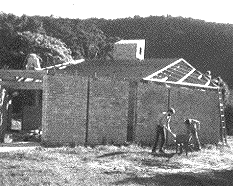
The completed building in the shape of a kite is a most beautiful place of worship and loved by locals and congregation alike. New toilets, and the renovation of the original church as a hall and meeting place, were completed in 1989 under the watchful eye and handy hand of Craig Knighton.
At Helensburgh some of the identities over this period were as follows: Ken Hammonds, the Rector’s Warden. Ken was to die of a heart attack while on a Parish Houseparty – a terrible loss.
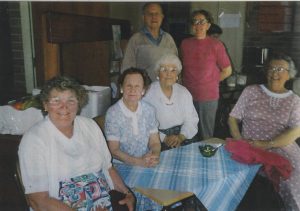 Gentle Folk L-R: Nancy Furner, Margaret Hammonds, Mary Higgins and Nova Duffy with Geoff Cox and Edwina Brookes
Gentle Folk L-R: Nancy Furner, Margaret Hammonds, Mary Higgins and Nova Duffy with Geoff Cox and Edwina Brookes
“The Gentle Folk”: Margaret Hammonds, Mary Higgins, Nova Duffy (who holds the record for the number of years of attending the Tuesday evening Bible Study), Nancy Furner, Pauline Luck, Ennis Fairbairn and Rona Powell who retired as the headmistress of the infants school in 1977. Mrs. Jeffries the organist left the district in 1977. Cathy and Geoff Hammonds, Kath and Bill Sweeny (Bill was a retired miner), Edwina Brooks, Barbara and John Rands, Marj Foster, Geoff Cox who had handed out the books on Sunday since the 1930s and was the only person able to ring the bell rhythmically, Colin and Narelle Adams, Bruce and Lee King, Jeff and Jan Lee, Rodger and Glenys Warner and family, Betty and Frank Marcey, Warren and Barbara Riley, John and Jean Parish and family who left for Canberra in 1982, Pam and Bill Johnson who owned the BP service station, Chris and Leigh Benger, Sid and Marilyn Moir (Marilyn became the church organist), Gail Davies, Jenny and Peter Mason, Marilyn and Steve Markham and family, Bob and Fran Grover and family who owned the Symbio animal park at Stanwell Tops, Rosemary Godfrey, Jeanette and Mark Patch, Claire and Doug Svensen, Greg Harris, Michael and Trish Croft and family, Amy and Mack McKay (Mack died in 1981 and Amy left the district in 1982), Stuart and Patricia Whelan and family, Kim and Ellen Crawford.
At Stanwell Park: Steve and Anne James and family, Chris and Judy Lambkin and family, Jean Anger, Norm and Stella O’Brien (Norm served with the Light Horse in Palestine), Marie and Ray Tinker and family, Reg and Carol Lobb and family, Michael and Julie Druce and family, Gary Laker, Wayne Bragg , David Anger, Eva Kinnish, Mr. and Mrs. Thoade, Judith Short, Graham and Lydia Allard and family.
The Findlaysons moved on in 1989. Bryan and Doreen to Braidwood while Bryan undertook further Biblical research before being appointed as Rector of St.Andrew’s Cronulla. On retiring they moved back to Helensburgh. The children remained in Helensburgh, having become Burghites, although Paul was to die of a brain tumor and is buried in the Helensburgh cemetery. Their eldest daughter, Marelle, later died of mesothelioma.
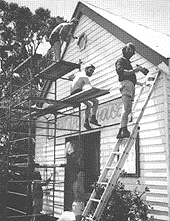 Another working bee on the Helensburgh hall, this time it was painting. The painters were the youth leaders at the time who helped run the Friday night youth club, the Jesus Light and Power Co. The date is the early ’80s. Up high, L to R, Jeff Lee, Kim Crawford and Bryan Findlayson. Down low, L to R, Sid Moir and Bruce King.
Another working bee on the Helensburgh hall, this time it was painting. The painters were the youth leaders at the time who helped run the Friday night youth club, the Jesus Light and Power Co. The date is the early ’80s. Up high, L to R, Jeff Lee, Kim Crawford and Bryan Findlayson. Down low, L to R, Sid Moir and Bruce King.
The Stanwell Park Church Committee, 1989. The Stanwell Park congregation has remained a strong and independent church to this day, always able to manage their own affairs.
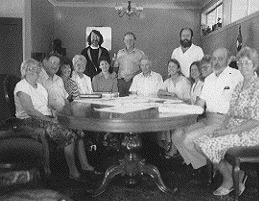 From left to right: Jean Anger, Ray Tinker, Marie Tinker, Molly Billings, Rev. Bryan Findlayson, Fran Grover, Bob Grover, Bob Starkey, Trish Croft, Mike Croft, Lydia Allard, Julie Druce, Reg Lobb, Carol Lobb.
From left to right: Jean Anger, Ray Tinker, Marie Tinker, Molly Billings, Rev. Bryan Findlayson, Fran Grover, Bob Grover, Bob Starkey, Trish Croft, Mike Croft, Lydia Allard, Julie Druce, Reg Lobb, Carol Lobb.
Rev. Tim Harris,
19 Dec 1989-16 Apr 1995
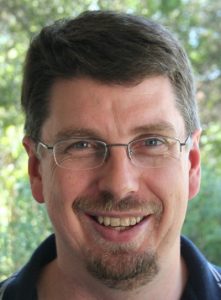
 Reverend Timothy J. Harris, with his wife Fiona and children Daniel, Jonathan and Jessica moved to Helensburgh at the end of 1989. Tim had been Assistant Minister at St Michael’s Cathedral in Wollongong for the previous four years. He became Curate-in-Charge of Helensburgh with Stanwell Park Provisional Parish on 19th December, 1989, setting as his goal for the church: “We are to represent Christ to the community of Helensburgh”.
Reverend Timothy J. Harris, with his wife Fiona and children Daniel, Jonathan and Jessica moved to Helensburgh at the end of 1989. Tim had been Assistant Minister at St Michael’s Cathedral in Wollongong for the previous four years. He became Curate-in-Charge of Helensburgh with Stanwell Park Provisional Parish on 19th December, 1989, setting as his goal for the church: “We are to represent Christ to the community of Helensburgh”.
Tim, an intelligent man of great integrity, and an accomplished teacher, along with his family were warmly welcomed, with a flurry of activity preceding their arrival – tidying up the grounds, painting the rectory and then providing meals for their first week as they got their bearings.
In 1990 the Helensburgh wardens were Sid Moir, Stuart Whelan, Jeff Lee and Lee King as Treasurer, while in Stanwell Park wardens were Reg Lobb, Fran Grover, Mike Croft. Parish Councillors were Michael Druce, Carol Lobb, Lydia Allard, Graham Wright, Bruce King, Fabian Corio and Geoff Cox, and Synod representative Max McKay. Of note three decades later Mike Croft is still one of the wardens, and Sid Moir is on Parish Council.
Tim and Fiona quickly got acquainted with parishioners and church ministries and activities. The first planning meeting on 4th February 1990 was preceded by a BBQ picnic in the church grounds. Many and varied activities and ministries included Sunday School, Scripture teaching (SRE), Mothers Union, Parish Houseparty, DT’s (Discipleship Training) nights, Ladies Weekend Away, and varied Children’s work – Friday Night Club (FNC), SPACE (Years 6-8), Junior Burghers, Junior Club (at The Park). Of note Jan Lee is also still teaching scripture three decades later. Others took youth retreats e.g. SPLASH from Stanwell Park going to Merry’s Beach, ‘Andy’s Crew’ with Andy Offord and Bruce King travelling for surf weekends, Parish BBQs, working bees, Friendship Morning at Garrawarra, Mary Higgins collecting stamps to raise funds for missions, all contributing to a vibrant group of believers serving with a keenness to engage all ages in their faith community. The “Gentle Folk”, the beloved seniors (including Nancy Furner, Margaret Hammonds, Nova Duffy, Mary Higgins, and Geoff Cox) also got together many a Sunday after church to hit the Scrabble board.
Many in the church whom the Harris’ got acquainted with are still in the area and in the church including Brookes, Croft, King, Lee, Moir, Powell, Johnston, Warner, Balderston and Mann families.
The weekly church bulletin (The Focus) in 1990 noted a special Archbishop’s Fund for the victims of the Newcastle Earthquake, and support for CMS missionaries, in a cassette ministry, by Mark and Narelle Stanbury in Zaire. (In 1997 Zaire was renamed the Democratic Republic of Congo). A while later when on furlough in Australia they described the harrowing sounds of the fighting they heard between the Hutu and Tutsi since they lived close to the border of Rwanda; and the incredible state of inflation in Zaire – describing brick-size amounts of notes taken to the market where prices escalated by the hour.
The first Easter services began with a new event of a candle-lit Passover Supper on the Thursday before, then on Good Friday: meditation and prayer on the Words of the Cross, culminating with an Easter Sunday sermon “Resurrection Belief: Hoax, Reality or Out of Date”, followed by a celebratory Resurrection Dinner (the 15th one) with spit roasted lamb at the Crofts at Stanwell Park.
The beginning of a collaborative mixed media mural was begun in 1990 too. The fondly nicknamed ‘Muriel” designed by Paul Naoum included sections made of cross-stitch, patchwork, timber, glass, tile etc made by the parishioners. Jeff Lee co-ordinated the project which was finally installed in the back wall of the church the following June (1991) to everyone’s delight, and hung there for many years.
Tim and his family were keen skiers and quite a few parishioners joined them at their annual ‘El Cheapo Budget’ ski weekend. Other parishioners joined the Moirs at their favourite camping spot at Wombeyan Caves.
The church year was full as usual with the Helensburgh Fete in August co-ordinated by Rodger Warner. In November a Garage Sale and Car Wash co-ordinated by Judith Short raised funds of $750 towards a new piano for Stanwell Park. The following August the piano was purchased with some additional funds from the Ladies Guild. In 1990 the church finances (self-supporting via parishioners’ contributions) budgeted a heady $24,831 p.a. Another innovation for Christmas was a contemplative service of ‘Nine Lessons and Carols’ on Christmas Eve.
 Photo: The 1990 Helensburgh Church fete in the church yard, the site of the original Rectory.
Photo: The 1990 Helensburgh Church fete in the church yard, the site of the original Rectory.
In 1991 ‘Summer Church in the Park” was held throughout February with the music from the band near the northern lagoon floating over the parkland – a BYO rug affair. A ‘Light Lunch’ at the Community Centre with Op Shop bargains also for sale catered mostly for the older members of the town. Amongst the prayers in this year were the Gulf War and bombings in Baghdad.
With 1992 being a significant 100 year anniversary of the Helensburgh Anglican Church a great deal of work was done to mark the occasion. A special Centenary Choir practised diligently under the direction of Marilyn Moir, a drama was rehearsed with Bronwyn Balderston and many hours at working bees to have the church grounds and building sparkling for the day. During the week itself a special Light Lunch was held then, on the Sunday at 1.30pm an afternoon tea at the Masonic hall in Robertson Street welcomed the Bishop of Wollongong. At 3pm people moved across to the church for the Centenary Service where Bishop Harry Goodhew spoke on the theme ‘The praise continues: witnesses to great news.’ The whole event was even videoed by Bruce King and Stuart Whelan.
1992 continued much as the year before with the addition of a combined service ‘One Body Fellowship’ or OBs, with other local churches at the Helensburgh Community Centre. This was a great opportunity to get to know other church goers, and various ministers in the town. ‘Hillcrest Happy Hour’ at Stanwell Park also began. Mary Higgins still faithfully urged folk to collect stamps.
The appointment of a catechist for the year 1993 – Leanne Burns, a fourth year Moore College student – assisted in the workload of the thriving parish with preaching and youth work. In the prayers for that year the end of the 30 year Civil War in Ethiopia and Eritrea; and the peace talks in Northern Ireland. Also prayers for the many miners who were retrenched in November from the Metropolitan Colliery. Jan Hindmarsh organised a Christmas gift hamper with mince pies for those affected families.
A new catechist, Celia Cross (second year Moore College student) replaced Leanne in 1994, and worked enthusiastically with the youth. Jean Anger received an award for 25 years of SRE, scripture teaching. A new playgroup was formed by parishioners Kathy Symons and Dianne Naoum. A puppet theatre was made by the Years 6-8 youth, called Time Out. The Stanwell Park youth, SPLASH held a pizza drive to raise funds for the children of Rwanda. Fittingly, 1994 was the ‘Year of the Family’.
In the prayers- Nelson Mandela, the President of South Africa; the Rwandan crisis; and the forthcoming Billy Graham Crusade (for following year 1995) which was to be relayed via satellite around the world.
In December 1994, Tim Harris was diagnosed with an irregularity in one of the ventricles of his brain, and thankfully had successful surgery relieving the pressure.
Early in 1995, Tim was approached to head up St Matthew’s church in Kensington, Adelaide. It was with sadness that the family were sent on their way to South Australia with a final celebration and goodbye on 16th April, Easter Sunday at the Resurrection dinner. (In later years Tim was ordained as a Bishop of Evangelism in Adelaide.) Tim’s parting words to his congregation: ‘I have a great sense of excitement about this parish … God is very much at work and great things are happening’.
As acting rector for the rest of the year, Archdeacon Ven. Dr Lindsay Stoddart looked after the church family. The congregation rallied during 1995, with the church wardens, Parish Council and catechist Celia Cross making sure all ran smoothly. Three ladies (Jan Hindmarsh, Kath Powell, Judith Short) shared administration work to get the newsletter out each week. Lindsay Stoddart, a forceful and energetic preacher took charge of the preaching. All normal activities and ministries continued, and a new adults monthly social event CLUB MAC was started by Ted and Terry Mann.
The planned confirmation service was held on 20th May, 1995 with Bishop Reg Piper officiating. Confirmees were of all ages: Jody Allard, Jean Anger, Jan Brooks, Esther Croft, Richard Grover, Robert Hutchings, Jacqui Lobb, Diane Oakey, Brad Powell and Lisa Simmons.
The announcement in June of the new curate-in-charge Trevor Young was delightfully received. (Jeff Lee spent much time organising needed work on the rectory, aided by Tim Symons). Trevor and his wife Rosemary with their children Bethany and Timothy moved from Belmore to the Helensburgh rectory on 13th September, 1995. They were welcomed with flowers, groceries and meals. Trevor’s induction service was held on Saturday 30th September with much enthusiasm.